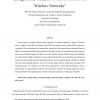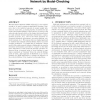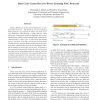1661 search results - page 128 / 333 » State-Driven Energy Optimization in Wireless Sensor Networks |
WINET
2011
13 years 3 months ago
2011
Sleep scheduling, which is putting some sensor nodes into sleep mode without harming network functionality, is a common method to reduce energy consumption in dense wireless sensor...
TWC
2008
13 years 8 months ago
2008
In this paper the tradeoff between energy and delay for wireless networks is studied. A network using a request-to-send (RTS) and clear-to-send (CTS) type medium access control (M...
PEWASUN
2007
ACM
13 years 9 months ago
2007
ACM
Wireless Sensor Network (WSN) technology is now mature enough to be used in numerous application domains. However, due to the restricted amount of energy usually allocated to each...
AINA
2009
IEEE
14 years 2 months ago
2009
IEEE
— Reprogramming node software over-the-air is an essential requirement in many wireless sensor network applications due to the inaccessibility of the deployed sensor nodes. Trans...
TMC
2010
13 years 6 months ago
2010
Energy efficiency is of the utmost importance in wireless sensor networks. The family of low-power-listening MAC protocols was proposed to reduce one form of energy dissipation�...



